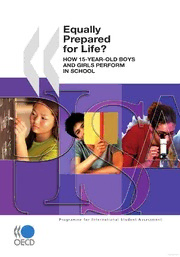
Equally prepared for life? [electronic resource] : how 15-year-old boys and girls perform in school PDF
Preview Equally prepared for life? [electronic resource] : how 15-year-old boys and girls perform in school
Equally Prepared for Life? HOW15-YEAR-OLDBOYS ANDGIRLSPERFORM INSCHOOL ProgrammeforInternational StudentAssessment «• OECD Copyrohledr Equally Prepared for Life? HOW15-YEAR-OLDBOYSANDGIRLSPERFORM INSCHOOL ProgrammeforInternationalStudentAssessment «• OECD Copyrightedr ORGANISATIONFORECONOMICCO-OPERATION ANDDEVELOPMENT TheOECDisauniqueforumwherethegovernmentsof30democraciesworktogetherto addresstheeconomic,socialandenvironmentalchallengesofglobalisation.TheOECDisalsoat theforefrontofeffortstounderstandandtohelpgovernmentsrespondtonewdevelopmentsand concerns,suchascorporategovernance,theinformationeconomyandthechallengesofan ageingpopulation.TheOrganisationprovidesasettingwheregovernmentscancomparepolicy experiences,seekanswerstocommonproblems,identifygoodpracticeandworktoco-ordinate domesticandinternationalpolicies. TheOECDmembercountriesare:Australia,Austria,Belgium,Canada,theCzechRepublic, Denmark,Finland,France,Germany,Greece,Hungary,Iceland,Ireland,Italy,Japan,Korea, Luxembourg,Mexico,theNetherlands,NewZealand,Norway,Poland,Portugal,theSlovakRepublic, Spain,Sweden,Switzerland,Tbrkey,theUnitedKingdomandtheUnitedStates.TheCommissionof theEuropeanCommunitiestakespartintheworkoftheOECD. OECDPublishingdisseminateswidelytheresultsoftheOrganisation’sstatisticsgatheringand researchoneconomic,socialandenvironmentalissues,aswellastheconventions,guidelinesand standardsagreedbyitsmembers. ThisworkispublishedontheresponsibilityoftheSecretary-GeneraloftheOECD.The opinionsexpressedandargumentsemployedhereindonotnecessarilyreflecttheofficial viewsoftheOrganisationorofthegovernmentsofitsmembercountries. ISBN978-92-64-06394-5(print) ISBN978-92-64-06407-2(PDF) CorrigendatoOECDpublicationsmaybefoundonlineat:www.oecd.org/publishing/corrigenda. PofIOSAE™C,DOtEraCdDe/maPrIkSsAi™sparnodhitbhietePdISwiAtlhooguotawrreitttreandpeemramkisssoifotnhefrOormgatnhiesaOtEiCoDn.forEconomicCo-operationandDevelopment(OECD).Alluse ©OECD2009 Yproouduccatnscionpyy,oudroownwlnodaodcourmpernitnst,OpErCesDenctoanttieonnts,fobrloygosu,rwoebwsnituesse,aannddtyeoacuhciangnmiantcelruidaelse,xcperropvtisdefdrotmhaOtEsCuiDtapbulbeliaccaktinoonwsl,eddagtmaebansteosfaOnEdCmDulatsismoeudricea paatenrdimncifoosp@scyioropinygrhtiotgphothw.onctoeomrcooirsptyghipevoeCrnet.niAotlnrlserofefrqautnhegisastismsafdto’ererxpipualblolifitocratopiruobcnloidmcumoedrrrocciiotamdlmeeurcscoeipaiaelnd(uCstFerCa)snhsaaltlalctoibnoetnaacrdtid@grchftecssosspeihdeosud.licrdoembc.telysutbomtihtetCeodptyorirgighhttsC@loeeacrd.aonrcge.CReenqtueerst(sCCfCo)r Foreword Inthepastfewdecadestherehasbeenanincreasinginterestinthedifferenteducationalexperiences,success andeventualoutcomesthatprevailformalesandfemales.Womenoftenexcelatschool,howevermen oftenearnmoreandaremorelikelytoholdpositionsofpowerinpoliticalandeconomiclife.Lookingat theseinequalities,governmentpoliciescannotaffordtobeRender-blind'andmustaimtodeveloppolicies forparity.Ifgovernmentswishtocreategrowth,employmentandabetterstandardofliving,policyadvice reflectinggenderdifferencesisneeded,andeducationcouldplayamajorroleinthis. Intheeducationalarea,thereareatleastthreereasonsforstudyinggenderdifferences.Theseincludeidentifying thesourceofinequalities,fosteringaverageperformanceandimprovingourunderstandingofhowstudents learn. Genderdifferencespointtoareaswherestudentbackground,attitudesandcharacteristicssignificantlyaffect studentperformance.Understandingwhatcaninfluencedifferencesinstudentperformancecanhelppolicy makersaddressqualityandequityconcerns.UsingdatafromtheOECD'sProgrammeforInternationalStudent Assessment(PISA),thisreportaddressesthefollowingquestions: Whydofemaleandmalestudentsperformdifferently? Whatdrivesgenderdifferences? Isthereaneedforgender-specificpolicies? Aretherespecificpoliciesthatwouldimprovemaleorfemalestudentperformance? PISAexplorestheeducationalperformanceandattitudesofadolescentmalesandfemales.Thisreportbeginswith ageneralsummaryofgenderdifferencesmeasuredindependentlyfromPISA.Itthenconsiderstheknowledge gainedaboutgender-relatedissuesthroughthePISA2000,PISA2003andPISA2006assessments. Somekeyfindingsinclude: InreadinginPISA2000,femalessignificantlyoutscoredmalesinallcountries. InmathematicsinPISA2003,malesoftenoutscoredfemales. InscienceoverallinPISA2006,therewasnosignificantdifferencebetweenmalesandfemalesinthe levelofperformance.However,whenexaminingthedifferentsciencecompetencies,femaleswerebetter thanmalesatidentifyingscientificissues,whilemaleswerebetteratexplainingphenomenascientifically. Malesandfemalesdidnothavesignificantlydifferentattitudestotoschoolscience,butlookingattheir futureaspirations,thereweremarkeddifferencesintheirexpectationsofhavingacareerinscienceat theageof30. ThereportistheproductofacollaborativeeffortbetweenthecountriesparticipatinginPISA,theexpertsand institutionsworkingwithintheframeworkofthePISAConsortium,andtheOECD.Thereportwasdraftedby JohnCresswell,MiyakoIkeda,MaciejJakubowski,AndreasSchleicher,SophieVayssettesandPabloZoido. ThedevelopmentofthereportwassteeredbythePISAGoverningBoard,whichischairedbyRyoWatanabe (Japan).ThereportispublishedontheresponsibilityoftheSecretary-GeneraloftheOECD. RyoWatanabe BarbaraIschinger ChairofthePISAGoverningBoard DirectorforEducation,OECD EQUALLYPREPAREDFORLIFE?HOW15-YEAR-OLDBOYSANDGIRLSPERFORMINSCHOOL-ISBN978-92-64-06394-5-©OECD2009 Table ofContents FOREWORD 3 READER'SGUIDE 6 GENDERMATTERS? 8 Whystudygenderdifferences? 8 Overview 9 WHATDOESTHELITERATURESAYABOUTGENDERDIFFERENCES FROMEARLYCHILDHOODTOTHELABOURMARKET? 9 Thestructureofthebrain 9 Primaryeducation 9 -Readingatgrade4(PIRLS) 9 -MathematicsandScienceatgrade4(TIMSS) 10 Secondaryeducation 10 -Mathematicsandscienceatgrade8(TIMSS) 10 -Secondarylevelattainment 10 Tertiaryeducation 12 -Entranceintotertiaryeducation 12 -Graduationfromtertiaryeducation 13 Labourmarket 15 WHATCANPISASAYABOUTGENDERDIFFERENCES? 15 WHATDIDPISA2000TELLUSABOUT GENDERDIFFERENCESINREADING? 16 Studentperformance 16 TrendsingenderdifferencesinreadingbetweenPISA2000 andPISA2006 17 Studentinterestandengagementinreading 17 OthergenderdifferencesfoundinPISA2000 18 WHATDIDPISA2003TELLUSABOUTGENDER DIFFERENCESINMATHEMATICS? 19 Studentperformance 19 TrendsingenderdifferencesinmathematicsbetweenPISA2003 andPISA2006 20 Studentattitudes 20 WHATDIDPISA2003TELLUSABOUTGENDER DIFFERENCESINPROBLEMSOLVING? 21 4 EQUALLYPREPAREDFORLIFE?HOW15-YEAR-OLDBOYSANDGIRLSPERFORMINSCHOOL-ISBN978-92-64-06394-5-©OECD2009 Copyrightedmaterial WHATDIDPISA2006TELLUSABOUTGENDERDIFFERENCESINSCIENCE?..22 ThePISAscienceframework 22 Studentperformance 23 -Overallperformanceinscience 23 -Performanceinthecompetencyidentifyingscientificissues 24 -Performanceinthecompetencyexplainingphenomenascientifically 27 -Performanceinknowledgeaboutscience 32 -Performanceinthe"Physicalsystems"areaofknowledgeofscience 32 -Performanceinthe"Livingsystems"areaofknowledgeofscience 33 -Performanceinthe"Earthandspacesystems"areaofknowledgeofscience..33 Genderdifferenceswithinschools 33 Atypologyofgenderdifferencesinscience 34 Computer-basedassessmentofscience(CBAS)inPISA2006 34 Studentattitudes 36 -Scienceperformanceandattitudestowardsscience 37 Studentbackground 38 -Socio-economicbackground 38 -Immigrantstatus 39 -Parentalinvolvement 41 Futurecareerorientation 41 -Informationonscience-relatedcareersandpreparationforthefuture 41 -Dostudentsexpecttopursueascientificcareer? 43 Schoolorganisation 44 -Singlesex-schooling 44 -FHomework 47 CONCLUSION 47 REFERENCES 50 APPENDIXA-BACKGROUNDOFPISA 52 ThedevelopmentofPISAsurveys 52 ThePISAstudentpopulation 52 KeyfeaturesofPISA2006 52 ThePISA2006scienceassessmentframework 54 DevelopmentofthescienceitemsinPISA2006 55 APPENDIXB-DATATABLES 56 EQUALLYPREPAREDFORLIFE?HOW15-YEAR-OLDBOYSANDGIRLSPERFORMINSCHOOL-ISBN978-92-64-06394-5-©OECD2009 Reader's Guide Dataunderlyingthefigures ThedatareferredtointhisreportarepresentedinAppendixBand,withadditionaldetail,onthePISA website(www.pisa.oecd.org).Fivesymbolsareusedtodenotemissingdata: a Thecategorydoesnotapplyinthecountryconcerned.Dataarethereforemissing. c Therearetoofewobservationstoprovidereliableestimates(i.e.therearefewerthan30students orlessthan3%ofstudentsforthiscell,ortoofewschoolsforvalidinferences). mDataarenotavailableorhavebeenremovedfortechnicalreasons. wDatahavebeenwithdrawnattherequestofthecountryconcerned. x Dataareincludedinanothercategoryorcolumnofthetable. CalculationoftheOECDaverage AnOECDaveragewascalculatedformostindicatorspresentedinthisreport.TheOECDaverage correspondstothearithmeticmeanoftherespectivecountryestimates. Roundingoffigures Becauseofrounding,somefiguresintablesmaynotexactlyadduptothetotals.Totals,differences andaveragesarealwayscalculatedonthebasisofexactnumbersandareroundedonlyafter calculation. Allstandarderrorsinthispublicationhavebeenroundedtotwodecimalplaces.Wherethevalue 0.00isshown,thisdoesnotimplythatthestandarderroriszero,butthatitissmallerthan0.005. Reportingofstudentdata Thereportuses"15-year-olds"asshorthandforthePISAtargetpopulation.PISAcoversstudentswho areagedbetween15years3monthsand16years2monthsatthetimeofassessmentandwhohave completedatleast6yearsofformalschooling,regardlessofthetypeofinstitutioninwhichtheyare enrolledandofwhethertheyareinfull-timeorpart-timeeducation,ofwhethertheyattendacademic orvocationalprogrammes,andofwhethertheyattendpublicorprivateschoolsorforeignschools withinthecountry. Reportingofschooldata Theprincipalsoftheschoolsinwhichstudentswereassessedprovidedinformationontheirschools' characteristicsbycompletingaschoolquestionnaire.Whereresponsesfromschoolprincipalsare presentedinthispublication,theyareweightedsothattheyareproportionatetothenumberof15- year-oldsenrolledintheschool. EQUALLYPREPAREDFORLIFE?HOW15-YEAR-OLDBOYSANDGIRLSPERFORMINSCHOOL-ISBN978-92-64-06394-5-©OECD2009 Reportingofparentdata Theparentsofthestudentswhowereassessedprovidedinformationontheirperceptionoftheirson's ordaughter'sschoolsandontheactivitiesundertakenbytheirchildrenattheageof10,bycompleting aparentquestionnaire. Abbreviationsusedinthisreport Thefollowingabbreviationsareusedinthisreport: ISCED InternationalStandardClassificationofEducation ISCO InternationalStandardClassificationofOccupations S.D. Standarddeviation S.E. Standarderror Significancetestsandsubgroupcomparisons Thesignificantstatisticsinthisreporthavebeenhighlightedinthefiguresandtables,usingdarker toneandboldprintrespectively.Forfurtherinformation,seetheAnnexA3inPISA2006:Science CompetenciesforTomorrow'sWorld(OECD,2007a). Furtherdocumentation ForfurtherinformationonthePISAassessmentinstrumentsandthemethodsusedinPISA,seethe PISA2006TechnicalReport(OECD,2009b)andthePISAwebsite(www.pisa.oecd.org). EQUALLYPREPAREDFORLIFE?HOW15-YEAR-OLDBOYSANDGIRLSPERFORMINSCHOOL-ISBN978-92-64-06394-5-©OECD2009 GENDERMATTERS? Forthepastfewdecadestherehasbeenanincreasinginterestinthedifferenteducationalexperiences, successandeventualoutcomesthatprevailformalesandforfemales.Theinterestinthisareawasfuelled inpartbyaperceivedlackofinterestandsuccessoffemalesinanumberofareasofschooling-notably mathematicsandthephysicalsciences.Inmorerecenttimestherehasalsobeenafocusonthelackof engagementandsuccessofmales,especiallyintheareaofreading. Educationalpolicyhastotakeintoaccounttheexistenceofgenderdifferencesinperformancetobeeffective inpromotingqualitystudentoutcomesandequity.ThisreportdrawsheavilyontheOECD'sProgrammefor InternationalAssessment(PISA)whereithasbeenfoundthatfemalestudentsdobetterinreading(OECD, 2001)andmalestudentsdosomewhatbetterinmathematics(OECD,2004).Inscience,thepictureismore complex.Ithasbeenfoundthatstudentattitudesandengagementexplain,inpart,genderdifferencein mathematicsandreading,afindingthat,byitself,canfosterabetterunderstandingofhowstudentslearn andtherebyhelpdesignmoreeffectiveeducationalpolicies(OECD,2007a). Thisreportwilllookatthedevelopmentofgenderrelatedissuesduringtheyearsofchildhoodand adolescence.Thereportwill: considerbrieflygenderdifferencesmeasuredoutsidethePISAassessmentprogramme; reviewtheknowledgegainedaboutgenderrelatedissuesfromPISA2000andPISA2003whenreading andmathematicsrespectivelywerethemajordomainsofassessment,withattentionalsopaidtothe relationshipbetweenstudentperformanceandstudentattitudes; considerinmoredetailtheresultsfromthemostrecentPISAsurvey,PISA2006,whensciencewasthe majorassessmentdomain,consideringalsostudentattitudestoscienceandtheenvironment. Whystudygenderdifferences? Thereareatleastthreereasonstostudygenderdifferences:i)tounderstandthesourceofanyinequalities; ii)toimproveaverageperformance;andiii)toimproveourunderstandingofhowstudentslearn.Gender differencespointtoareaswherestudentbackgroundandcharacteristicssignificantlyaffectstudent performance.Understandingwhatdrivesdifferentialstudentperformancecanfosterthedesignofeffective educationalpoliciestoaddressqualityandequityconcerns.Whydofemaleandmalestudentsperform differently?Whatdrivesgenderdifferences?Isthereaneedforgenderspecificpolicies?Aretherespecific policiesthatwouldimprovemaleorfemalestudentperformance?Thesearesomeofthequestionsthatcan beanalysedbylookingintogenderdifferences. Theimperativeforgenderequitycanbeseeninanumberoflights.Firstlythereisamoralreasontoensure thatoneofthesexesisnotdisadvantagedcomparedtotheother.Thedisadvantagemaybetheendresult ofmanyyearsoftreatmentbasedonculture,religionandtradition.Thesecondimperativetoraisingthe performanceofoneofthesexestobesimilartotheotheristheconcomitantincreaseineconomicand socialbenefitsthatthiswillbring.BelfieldandLevin(2007)calculatedthecostsandbenefitsassociated withanincreaseineducationlevel(asmeasuredbyhighschoolgraduation).Theyfoundthatthereare bothprivatebenefitstotheindividualwhograduatesandfiscalbenefitstothetaxpayerthroughhighertax revenuesbecauseofincreasedearningsandlowergovernmentexpendituresonhealth,crime,welfare, remedialeducationandotherpublicservices. Thecountrieswiththesmallestnumberofgenderdifferencesinperformancesandattitudes(Table3.21, OECD,2007a)includePortugal,Poland,Belgium,Switzerland,Ireland,Mexico,theSlovakRepublicand EQUALLYPREPAREDFORLIFE?HOW15-YEAR-OLDBOYSANDGIRLSPERFORMINSCHOOL-ISBN978-92-64-06394-5-©OECD2009
